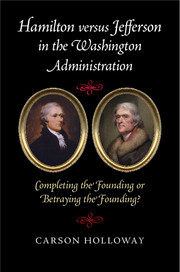 Hamilton versus Jefferson in the Washington Administration
Hamilton versus Jefferson in the Washington Administration Book contents
- Frontmatter
- Dedication
- Contents
- Acknowledgments
- 1 Introduction
- PART I A DEBATE BETWEEN CABINET COLLEAGUES
- 2 Establishing the Public Faith: Hamilton's Report on Public Credit
- 3 First Signs of Division: Assumption and the Back Pay Bill
- 4 Establishing Energetic Government: Hamilton's Report on a National Bank
- 5 Defending Limited Government: Jefferson's Critique of the Constitutionality of the National Bank
- 6 Defending Energetic Government: Hamilton on the Constitutionality of the National Bank
- PART II A CLASH OF RIVAL PARTY LEADERS
- PART III Founding Foreign Policy
- Index
2 - Establishing the Public Faith: Hamilton's Report on Public Credit
from PART I - A DEBATE BETWEEN CABINET COLLEAGUES
Published online by Cambridge University Press: 05 November 2015
- Frontmatter
- Dedication
- Contents
- Acknowledgments
- 1 Introduction
- PART I A DEBATE BETWEEN CABINET COLLEAGUES
- 2 Establishing the Public Faith: Hamilton's Report on Public Credit
- 3 First Signs of Division: Assumption and the Back Pay Bill
- 4 Establishing Energetic Government: Hamilton's Report on a National Bank
- 5 Defending Limited Government: Jefferson's Critique of the Constitutionality of the National Bank
- 6 Defending Energetic Government: Hamilton on the Constitutionality of the National Bank
- PART II A CLASH OF RIVAL PARTY LEADERS
- PART III Founding Foreign Policy
- Index
Summary
According to one account, George Washington, having been elected America's first president, and pondering the challenges his administration would confront, asked revolutionary financier Robert Morris what the new government should do about the nation's considerable debts. Said Morris: “There is but one man in the United States who can tell you; that is, Alexander Hamilton.”
If Morris exaggerated, it was not by much. And if the story is apocryphal – in relating it, Hamilton biographer Forrest McDonald admits that it is based on “secondhand recollections” – it still points to an important truth: Hamilton was probably as uniquely prepared to be the nation's first secretary of the treasury as Washington was to be its first president. Hamilton certainly knew more about finance than any of the leading founders, and it is probably not an overstatement to say that among that crowd of very able men he was singularly qualified to confront the infant republic's daunting financial difficulties. He had taken special pains to acquire the knowledge he would need for such a task. While serving as Washington's aide de camp during the Revolution, Hamilton had used his spare moments to study texts such as Malachy Postlewayt's Universal Dictionary of Trade and Commerce and Richard Price's Schemes for Raising Money by Public Loans. Later, he read the three-volume memoirs of French finance minister Jacques Necker, which provided him, in McDonald's words, with a “veritable encyclopedia of practical information on fiscal management.”
The new secretary of the treasury would need all of his considerable financial acumen to address the country's fiscal challenges. As historian Darren Staloff observes, the government Hamilton was to serve “had inherited a staggering burden of debt” as the cost of the Revolution. The United States owed about $13 million to foreign lenders and about $40 million to domestic creditors. On top of this, the state governments had on their own account borrowed a total of $25 million to pay for their contributions to the war effort. The annual interest on these debts far outstripped the government's expected annual revenues. Indeed, in terms of the debt-to-revenue ratio, American indebtedness was huge by the standards of the day. Numerically, Britain's debt was much larger than America's, but then Britain also commanded a much larger revenue. In terms of its ability to pay, then, America's debt was twice as big as Britain's.
- Type
- Chapter
- Information
- Hamilton versus Jefferson in the Washington AdministrationCompleting the Founding or Betraying the Founding?, pp. 9 - 37Publisher: Cambridge University PressPrint publication year: 2015


